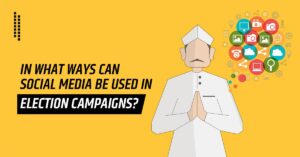 In recent times, with the advent of globalization and digitalization, the use of technology has witnessed a substantial increase. From social media to chat rooms and instant messaging, communication has changed since the dawn of the Internet era. According to Digital 2023: India Report, there were 692.0 million internet users in India in January 2023. In the realm of online communication, social media is the newest and fastest-growing phenomenon. As a result, social media has also penetrated the political sphere. Increasingly, politicians and other elected officials are beginning to understand the role of social media in communicating political information and interacting with citizens. It has been widely observed that social media undoubtedly has a significant impact on opinion formation and public mobilization. In India, governments have been using social media to propagate the welfare activities carried out by them and to reach the public at large to address their grievances.
In recent times, with the advent of globalization and digitalization, the use of technology has witnessed a substantial increase. From social media to chat rooms and instant messaging, communication has changed since the dawn of the Internet era. According to Digital 2023: India Report, there were 692.0 million internet users in India in January 2023. In the realm of online communication, social media is the newest and fastest-growing phenomenon. As a result, social media has also penetrated the political sphere. Increasingly, politicians and other elected officials are beginning to understand the role of social media in communicating political information and interacting with citizens. It has been widely observed that social media undoubtedly has a significant impact on opinion formation and public mobilization. In India, governments have been using social media to propagate the welfare activities carried out by them and to reach the public at large to address their grievances.
According to the Ministry of Information and Broadcasting, social media is now officially a part of the Indian government. Almost every political party, including the party of the incumbent government, has its social media wing to take care of the political campaign and have budget allocation for the same. With 89.45 million followers, Prime Minister, Mr. Narendra Modi is the most followed Indian on Twitter. In the 2019 general elections, Narendra Modi employed social media as a powerful tool for his campaign, making him one of the pioneering Indian leaders to recognize the importance of social media in political advertising.

This growing use of social media in politics can be attributed to various factors. Parties can reach a wider audience by live-streaming speeches, rallies, and events on platforms like Facebook and YouTube. Through this, political parties not only involve people who are unable to attend events in person but successfully influence the decisions of voters. Unlike the traditional media, it has no time constraints and is able to reach a wider audience in a very short period of time. According to Google Transparency Report, political parties mostly in the years 2021 and 2022 have spent around 800 million dollars (Rs 5,900 crore) on election ads. Social media also allows users to comment, like, share, and engage with content, which allows for a more dynamic and two-way communication. Parties and candidates can respond to questions, concerns, and feedback in real-time, creating a sense of accessibility and engagement that traditional media cannot easily replicate. It also facilitates politicians to share their instant reactions or views on a recent subject. It has also been noted that social media can be utilized for crisis management and damage control in case of unfavourable events or controversies. For instance, in May 2022 amidst unprecedented international outcry following the Islamophobic remarks made by Bharatiya Janata Party (BJP) official spokespersons, Nupur Sharma and Naveen Kumar Jindal, the Union government distanced itself from the controversy. BJP’s social media team took an active posture in responding to controversies around the political remarks made. They issued statements and tried to sway the public conversation towards their policy goal. By doing so, they aimed to manage the crisis and limit the potential damage to the party’s reputation.

Apart from influencing the voting pattern and winning over the audience, social media is an effective tool for citizens. Social media provides a direct and accessible platform for voters to question their leaders and office-bearers, facilitating greater transparency and accountability. During the early stages of the pandemic in 2020, there were concerns and questions about the government’s response, healthcare infrastructure, and the availability of medical supplies. In response, political leaders and government agencies used their official social media accounts to provide updates, share resources, and address the concerns raised by the public.
Though the development of the internet and social media is one of the biggest boons for the political fabric of the country, one cannot overlook its negative aspects. One major problem in the Indian elections has been the spreading of false information and fake news on social media platforms. False narratives and manipulated images or videos have sometimes gone viral, leading to confusion among voters and potentially influencing their decisions. Sometimes specific communities or groups are targeted engineering communal tensions and unrest during the election period. One notable instance of communal tension was the 2013 Muzaffarnagar riots in the northern state of Uttar Pradesh. The Muzaffarnagar riots occurred in the run-up to the 2014 Lok Sabha (national) elections. Their social media played a role in the escalation of communal tensions because of misinformation and the circulation of provocative videos on platforms like Facebook and WhatsApp. Online harassment, trolling, and cyberbullying of the opposition candidate by the supporters of the other candidate is the most common phenomenon occurring during the campaigning period. 
Nonetheless, social media is expected to play a pivotal role in shaping the narrative and influencing voter opinion in the ongoing general elections of 2024 in India. With BJP and Congress spending the largest on political ads on digital platforms, it would be an interesting contest for online viewers and voters.

